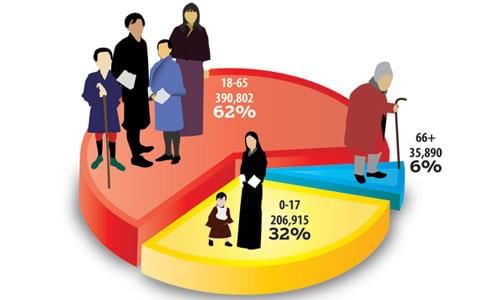NCERT Solutions for Class 8 Geography Chapter 5 - Human Resources
Q1. Answer the following questions.
(i) Why are people considered a resource?
Ans: People are considered resources because they can produce new resources with their demands and capabilities. Nature's abundance is only valuable when people discover it and put it to good use. They gain abilities and aptitudes through education, good health, and motivation, allowing them to become more proficient in overcoming obstacles and hurdles and carrying out more duties effectively. As a result, human resources are regarded as valuable and potentially valuable resources for society.
 Human as a resource
Human as a resource
(ii) What are the causes for the uneven distribution of population in the world?
Ans: The distribution of population in the world is uneven - some areas are very crowded while some are sparsely populated. There are various reasons behind uneven distribution:
- Geographical factors: Favourable topography, availability of mineral and freshwater resources, favorable climate, and soil fertility are some of the reasons affecting population distribution, e.g., Indo Gangetic Plains, Diamond Mines of South Africa, etc. are densely populated.
- Social and Cultural factors: Areas with better housing, education, and health facilities are more populated. Places of religious and cultural significance also attract people, e.g., Varanasi, Jerusalem, etc.
- Economic factors: Places with more industries, transportation, and communication facilities provide better employment opportunities. People are attracted to these places for the above reasons, e.g., Mumbai, Osaka, etc.
(iii) The world population has grown very rapidly. Why?
Ans: The world population has grown very rapidly because the death rate has gone down as a result of the growth of food supplies and the improvement of medical facilities. Also, unlike the death rate, the birth rate has remained quite high.
(iv) Discuss the role of any two factors influencing population change.
Ans: The birth rate and the death rate are two factors that influence population change. The birth rate is the number of live births per 1000 people, while the death rate is the number of deaths per 1000 people. These are the natural causes of population change.
When the birth rate is higher than the death rate, the population increases. When the death rate is more than the birth rate, the population decreases. When the two rates are equal, the population remains constant. Thus, the birth and death rates affect the balance of the population.
The population remains constant when the two rates are equal. As a result, birth and death rates have an impact on population balance. People can travel both within and between countries. Migration is another factor that influences population change.
 Example of population composition
Example of population composition
(v) What is meant by population composition?
Ans: The basic structure of the population is referred to as population composition. The number of males and females, their age groups, ethnicity, tribe, language, religion, literacy, occupation, income level, and health problems, among other things, are all determined by the population composition.
(vi) What are population pyramids? How do they help in understanding about the population of a country?
Ans: The graphical illustration that is used for studying the population composition of a country is called a population pyramid. It shows the present number of males and females in a country, along with their age groups. The age-group distribution of the population tells us the number of dependents and the number of economically active individuals present in the population.
Population pyramid
Q2. Tick the correct answer.
(i) Which does the term population distribution refer to?
(a) How population in a specified area changes over time.
(b) The number of people who die in relation to the number of people born in a specified area.
(c) The way in which people are spread across a given area.
Ans: (c) The way in which people are spread across a given area.
It can also be defined as a pattern of where people live.
(ii) Which are three main factors that cause population change?
(a) Births, deaths and marriage
(b) Births, deaths and migration
(c) Births, deaths and life expectancy
Ans: (b) Births, deaths and migration
Births cause an increase in population whereas deaths cause a decrease. Migration refers to the phenomenon when people move from one place to another. Thus all three cause a change in population.
(iii) In 1999, the world population reached
(a) 1 billion
(b) 3 billion
(c) 6 billion
Ans: (c) 6 billion
According to the United Nations, the world's human population reached 6 billion on October 12, 1999.
(iv) What is a population pyramid?
(a) A graphical presentation of the age, sex composition of a population.
(b) When the population density of an area is so high that people live in tall buildings.
(c) Pattern of population
Ans: (a) A graphical presentation of the age, sex composition of a population.
A graphical presentation of the age and sex composition of a population. The Population Pyramid starts from the youngest at the bottom to the oldest at the top.
Q3. Complete the sentences below using some of the following words.
sparsely, favourable, fallow, artificial, fertile, natural, extreme, densely
When people are attracted to an area it becomes ___________ populated. Factors that influence this include _________ climate; good supplies of ____________ resources and _____________ land.
Ans: When people are attracted to an area it becomes densely populated. Factors that influence this include favourable climate; good supplies of natural resources and fertile land.
|
69 videos|431 docs|46 tests
|
FAQs on NCERT Solutions for Class 8 Geography Chapter 5 - Human Resources
| 1. What is the importance of human resources in an organization? |  |
| 2. How does human resource management contribute to the overall success of a company? |  |
| 3. What are some common challenges faced by human resource managers in today's business environment? |  |
| 4. How does strategic human resource planning help organizations achieve their long-term goals? |  |
| 5. What are some best practices for effective human resource management in an organization? |  |






















